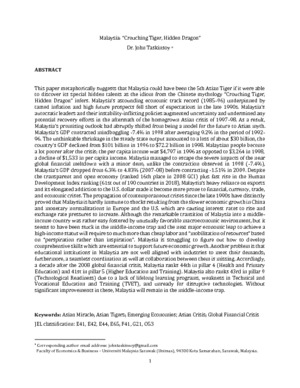- Suggested keywords :
- social(3)
- archaeological(3)
- species(3)
- areas(2)
- polar(4)
List of Categories and SubCategories
Change Your Picture

Malaysia: “crouching Tiger, Hidden Dragon”
JOHN TASKINSOY
VIEWS
1650
INFO
more

- Category : Business
- Size : 1902303
- By : JOHN TASKINSOY



Using Your Google Account
Google Login/Sign up
OR
Recover Your Password
Abstract
This paper metaphorically suggests that Malaysia could have been the 5th Asian Tiger if it were able to discover its special hidden talents as the idiom from the Chinese mythology “Crouching Tiger, Hidden Dragon” infers. Malaysia’s astounding economic track record (1985-96) underpinned by tamed inflation and high future prospects fell short of expectations in the late 1990s. Malaysia’s autocratic leaders and their instability-inflicting policies augmented uncertainty and undermined any potential recovery efforts in the aftermath of the homegrown Asian crisis of 1997-98. As a result, Malaysia’s promising outlook had abruptly shifted from being a model for the future to Asian myth. Malaysia’s GDP contracted mindboggling -7.4% in 1998 after averaging 9.2% in the period of 1992-96. The unthinkable shrinkage in the steady state output amounted to a loss of about $30 billion, the country’s GDP declined from $101 billion in 1996 to $72.2 billion in 1998. Malaysian people become a lot poorer after the crisis; the per capita income was $4,797 in 1996 as opposed to $3,264 in 1998, a decline of $1,533 in per capita income. Malaysia managed to escape the severe impacts of the near global financial meltdown with a minor dent; unlike the contraction observed in 1998 (-7.4%), Malaysia’s GDP dropped from 6.3% to 4.83% (2007-08) before contracting -1.51% in 2009. Despite the transparent and open economy (ranked 16th place in 2008 GCI) plus fast rise in the Human Development Index ranking (61st out of 190 countries in 2018), Malaysia’s heavy reliance on exports and its elongated addiction to the U.S. dollar made it become more prone to financial, currency, trade, and economic crises. The propagation of contemporaneous crises since the late 1990s have distinctly proved that Malaysia is hardly immune to shocks resulting from the slower economic growth in China and monetary normalizations in Europe and the U.S. which are causing interest rates to rise and exchange rate pressures to increase. Although the remarkable transition of Malaysia into a middle-income country was rather easy fostered by unusually favorable macroeconomic environment, but it seems to have been stuck in the middle-income trap and the next major economic leap to achieve a high-income status will require so much more than cheap labor and “mobilization of resources” based on “perspiration rather than inspiration”. Malaysia is struggling to figure out how to develop comprehensive skills which are essential to support future economic growth. Another problem is that educational institutions in Malaysia are not well aligned with industries to meet their demands; furthermore, a seamless coordination as well as collaboration between them is missing. Accordingly, a decade after the 2008 global financial crisis, Malaysia ranks 44th in pillar 4 (Health and Primary Education) and 41st in pillar 5 (Higher Education and Training). Malaysia also ranks 43rd in pillar 9 (Technological Readiness) due to a lack of lifelong learning programs, weakness in Technical and Vocational Education and Training (TVET), and unready for disruptive technologies. Without significant improvements in these, Malaysia will remain in the middle-income trap.
Recommended Papers

